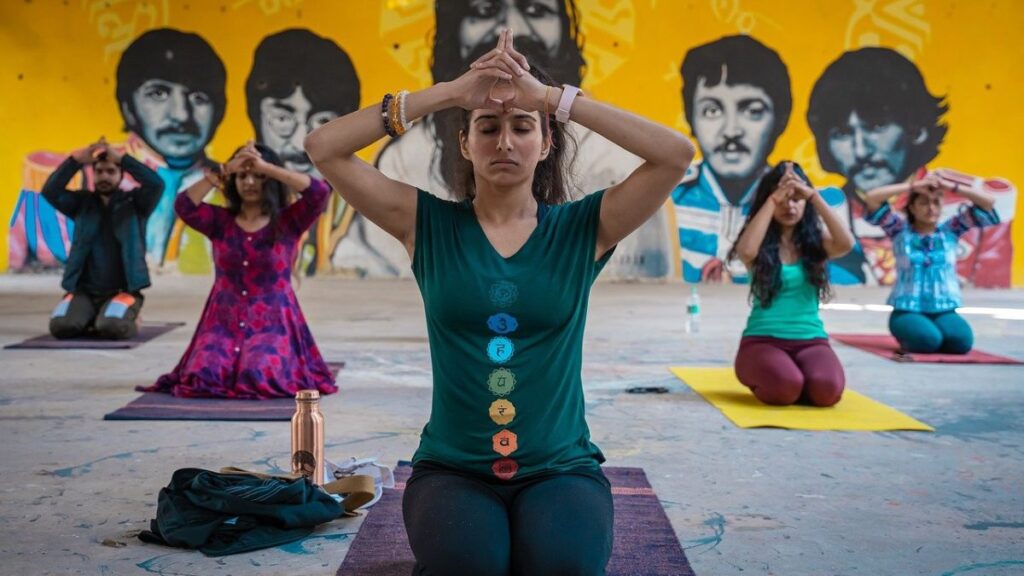Kundalini Yoga is a special kind of yoga that some people say might be risky. This article talks about Why is Kundalini Yoga Dangerous? what Kundalini Yoga is?
Kundalini Yoga is not just regular yoga. It’s a special type that does more than just body stretches. It includes deep meditation (sitting quietly and thinking), breathing in special ways, and chanting (saying certain words over and over).
People do Kundalini Yoga to feel more peaceful and to connect with their spiritual side. But, some people worry that it might not be safe for everyone.
In this article, we’ll talk more about what Kundalini Yoga is, what this special Kundalini energy is, and why some people think this yoga can be dangerous. We want to help you understand this kind of yoga better, so you can decide if it’s right for you.
Contents
What is Kundalini Yoga?
Kundalini Yoga is a type of yoga that’s a bit different from the yoga most people know. It’s not just about doing poses and stretching. Instead, it focuses a lot on your mind and spirit. In Kundalini Yoga, you do a mix of things like:
- Breathing Exercises: You breathe in special ways that are different from normal breathing. This is to help you feel more energy.
- Yoga Poses: These are body positions that can be simple or a bit hard. They help your body get stronger and more flexible.
- Meditation: This is when you sit quietly and try to clear your mind. It’s like giving your brain a peaceful break.
- Chanting: Saying special words or sounds over and over. It’s a way to focus your mind and feel calm.
What Is Kundalini Energy?
Kundalini energy is a special part of Kundalini Yoga. It’s like a strong energy that sleeps in your body, down at the bottom of your spine. It’s often pictured as a sleeping snake. In Kundalini Yoga, you do certain exercises to wake up this energy.
When this energy wakes up, it moves up your spine to the top of your head. This can make you feel very different, like you’re more aware or really peaceful. Waking up this energy is a big part of Kundalini Yoga. It’s supposed to help you feel more connected to yourself and everything around you. But because it’s so strong, you need to be careful. Doing Kundalini Yoga without knowing how or without a good teacher can be too much for some people.
Different Techniques of Kundalini Yoga
Kundalini Yoga incorporates various techniques to awaken and harness the spiritual energy believed to reside at the base of the spine. Here are some key techniques commonly used in Kundalini Yoga.
1. Asanas (Physical Postures)
Kundalini Yoga involves special body postures to wake up and balance the body’s energy centers, called chakras. These postures are not still and often include moving and repeating certain motions.
These unique poses are designed to help energy flow smoothly through the body. Practicing these postures is believed to prepare the body for the awakening of the kundalini energy.
During Kundalini Yoga, you might find yourself doing dynamic movements or holding specific positions to activate different parts of the body. These physical postures are a key part of the practice, helping to promote both physical and spiritual well-being.
2. Pranayama (Breath Control)
In Kundalini Yoga breath is not just about inhaling and exhaling. It’s a tool for controlling and enhancing the flow of energy. This is called pranayama.
Pranayama techniques in Kundalini Yoga can involve breathing patterns like rapid, rhythmic breathing, or alternate nostril breathing. These breath exercises are believed to awaken and move the kundalini energy within the body.
By consciously manipulating the breath, Doctors aim to balance the energy channels and increase awareness. Breathing becomes a powerful means to connect the body, mind, and spirit in the practice of Kundalini Yoga.
For more information Why Does Yoga Make Me Nauseous? visit this post.
3. Mudras (Hand Gestures)
Mudras are like secret codes using your hands. In Kundalini Yoga, these hand gestures are part of the practice to influence the energy flow in your body.
By placing your fingers in specific positions, you’re thought to create a kind of energy circuit. This circuit helps direct the kundalini energy to different areas, working in harmony with the overall practice.
Mudras can be integrated into meditation or combined with breathwork. They are like little energy switches, enhancing the flow and balance of your inner energy.
4. Mantras (Chanting)
Kundalini Yoga is not just about the poses and breath; it’s also about the power of sound. Mantras, which are sacred sounds or phrases, play a significant role.
Practitioners chant these mantras to create vibrations that resonate through the body. The vibrations are believed to stimulate the energy centers and awaken the kundalini energy.
Chanting can be rhythmic, and the sound itself is considered a powerful force for spiritual awakening. It’s a way to connect with a deeper part of yourself and the universal energy.
5. Kriyas (Sets of Exercises)
Kriyas are like customized routines for your energy system in Kundalini Yoga. These are specific sets of exercises, including movements, breathwork, and sometimes chanting, carefully designed to produce particular effects.
Each kriya has a specific purpose—some might focus on cleansing, others on energizing. They’re like a holistic workout for your body, mind, and spirit.
Practicing kriyas helps balance different aspects of yourself. The structured sequences are intended to guide the flow of energy in a way that contributes to overall well-being.
6. Bandhas (Energy Locks)
Bandhas are like energy locks that you use to control the flow of energy within your body. There are specific muscles or areas that you contract or lock in a particular way to guide the energy.
The idea is to create a sort of internal dam, allowing the kundalini energy to accumulate and move in a controlled manner. This can intensify the overall experience of the practice.
Commonly, there are three main bandhas: Mula Bandha (root lock), Uddiyana Bandha (abdominal lock), and Jalandhara Bandha (throat lock). Each serves a unique purpose, contributing to the regulation and direction of energy flow.
5 Reasons Why Kundalini Yoga Dangerous?
Kundalini Yoga is a practice embraced by many for its potential benefits, some concerns and criticisms suggest potential risks. Here are five reasons why some view Kundalini Yoga as potentially dangerous.
1. Physical Movements
Kundalini Yoga involves some pretty energetic moves. For beginners or people with health issues, these intense physical exercises could lead to injuries. It’s like doing acrobatics with your body, so it’s important to be cautious, especially if you’re just starting out.
The healthy motions in Kundalini Yoga might not be suitable for everyone. It’s crucial to listen to your body, take it slow, and, most importantly, seek guidance from a qualified instructor to prevent any strain or harm.
2. Psychological Challenges
Kundalini Yoga isn’t just about moving your body; it aims to wake up something deep inside you. This awakening process can bring about intense psychological experiences. Like feeling different emotions strongly or even having unusual thoughts.
For some, these psychological challenges might be overwhelming, especially without the right support. It’s a bit like opening a door to your emotions and thoughts, and it can be a lot to handle. This is why having a knowledgeable guide or teacher is crucial to help navigate these intense feelings and keep things balanced.
3. Lack of Standardization
Kundalini Yoga doesn’t have a one-size-fits-all rule book. Unlike some other types of yoga, there isn’t a universal guide everyone follows. This lack of standardization means that different teachers might have different styles, and things can get a bit confusing.
Think of it like cooking without a recipe – everyone might add different ingredients. While this flexibility can be good, it also means there’s room for misunderstandings or doing things in a way that might not suit everyone.
4. Energy Imbalances
Kundalini Yoga is all about energy specifically, waking up the energy inside you. But, if not done carefully, it might upset the balance. Picture it like tinkering with the electricity in your house without knowing what each switch does!
Some believe that messing with this internal energy flow without proper guidance could cause disruptions. This might show up as physical discomfort or emotional ups and downs. It’s a bit like trying to fix your computer without knowing much about it; you might make things worse.
5. Not Suitable for Everyone
Kundalini Yoga is like a tool it’s super helpful for some, but not everyone should use it. It’s a bit like medicine; what works for one person might not be good for another.
If you have certain health conditions, like heart problems or epilepsy, or if you’re dealing with mental health issues, Kundalini Yoga might not be the best choice. It’s a bit like having specific dietary restrictions; not every food suits every person.
Pros of Kundalini Yoga
Kundalini Yoga is appreciated by many for its potential positive effects on physical, mental, and spiritual well-being. Here are some of the pros of practicing Kundalini Yoga.
- Complete Well-being: Kundalini Yoga cares for your whole self your body, mind, and spirit. It’s like a one-stop shop for feeling good in every way.
- Spiritual Upliftment: Practicing Kundalini Yoga often leads to a stronger connection to something beyond ourselves. It’s like adding a special kind of energy to our lives, making things more meaningful.
- Stress Reduction Toolkit: With its mix of movements, breathing exercises, and meditation, Kundalini Yoga is like having tools for stress relief. It helps you relax, making it easier to handle life’s challenges.
- Enhanced Flexibility and Strength: Kundalini Yoga includes poses that make your body more flexible and strong. It’s like a gentle workout that keeps you physically fit and healthy.
- Vitality Boost: The practice of Kundalini Yoga activates a unique energy inside you. Many describe it as a burst of vitality, providing a natural boost to your overall energy levels.
- Emotional Release and Strength: Kundalini Yoga allows for the release of stored emotions, offering relief and building emotional strength. It’s like creating space for your feelings to flow freely.
Cons of Kundalini Yoga
While Kundalini Yoga has its benefits, there are concerns and potential drawbacks associated with the practice. Here are some cons or considerations related to Kundalini Yoga.
- Psychospiritual Crisis: Kundalini Yoga might bring on intense experiences known as a kundalini crisis. It’s like a strong wave of emotions or thoughts that can be challenging to handle. If this happens, getting professional help is crucial for understanding and managing these experiences.
- Spiritual Bypassing: Sometimes, people use Kundalini Yoga to avoid dealing with their real-life issues. It’s like putting a temporary cover on problems instead of facing them. Personal development and healing may be restricted by this “spiritual bypassing”.
- Unpleasant Physical Sensations: When awakening kundalini energy, you might feel unusual physical sensations, like heat or tingling. While some see it as normal, others may find it uncomfortable or weird.
- Safety Concerns Without Guidance: Doing Kundalini Yoga without proper guidance or from inexperienced instructors can be risky. It’s like driving without a map having a qualified teacher helps you navigate the journey safely.
- Overemphasis on Rapid Transformation: Kundalini Yoga sometimes pushes for quick spiritual changes. It’s like expecting instant results. This rush might create unnecessary stress or disappointment. Taking things at your own pace is key to a positive experience.
Tips To Practice Kundalini Safely
Here are some tips to ensure a safe and positive Kundalini Yoga experience:
Qualified Guidance
Choose a certified Kundalini Yoga instructor with experience. A good teacher guides you safely through practices, ensuring you understand the techniques and preventing potential pitfalls. They act like a trustworthy navigator on your yoga journey.
Start Gentle
Begin with beginner-friendly poses and techniques. Slowly introduce advanced elements as you become more comfortable. It’s like learning to swim; you start with the basics and gradually move to deeper waters, ensuring you feel confident at every step.
Listen to Your Body
If a particular posture causes you pain or discomfort, adjust it or avoid it. Think of it like driving a car; if the road feels bumpy, you adjust your speed. Similarly, in Kundalini Yoga, listen to your body’s signals and adjust your practice accordingly.
Hydration Matters
Kundalini Yoga can work up a sweat. Keep hydrated by drinking water before and after practice. It’s like fueling your car before a long journey with hydration supports. Your body’s energy ensures a smoother ride.
Balance and Progress Gradually
Aim for balance in your practice, combining physical postures, breathwork, and meditation. Think of it as a well-rounded meal for your body and mind. Gradually progress, allowing your practice to evolve naturally. It’s akin to nurturing a plant; you provide the right balance of sunlight and water for steady growth.
FAQs
Why is Kundalini yoga so powerful?
Kundalini Yoga is powerful because it taps into dormant energy (kundalini) at the base of the spine, aiming for spiritual growth. It uses a mix of movements, breathing, and meditation, engaging the whole self.
What happens if you awaken Kundalini?
Awakening Kundalini is believed to bring heightened awareness, a deeper spiritual connection, and increased energy flow through the body. People might experience altered consciousness, emotional release, and changes in perception.
Can kundalini awakening be physically painful?
Yes, Kundalini awakening can be accompanied by physical sensations, and for some individuals, these sensations may include discomfort or pain. People undergoing Kundalini awakening have reported sensations such as heat and intense energy movements.
Conclusion
Our discussion on Kundalini Yoga, it’s a bit like starting a new adventure. But with a need for careful steps. Kundalini Yoga offers spiritual growth, yet it’s not a universal fit.
For those with health concerns, chatting with a doctor before diving in is a smart move. Each person’s journey is different, and having a certified instructor is like having a knowledgeable friend to guide you through the process.
Think of Kundalini Yoga as a powerful tool that can bring intense experiences. Taking it slow is important, much like a steady hike up a mountain. Finding your pace, respecting your limits, and staying aware are keys to a positive journey.







